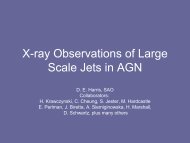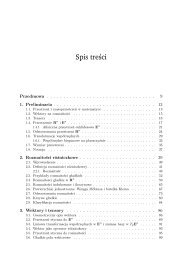Jets from X-ray binaries
Jets from X-ray binaries
Jets from X-ray binaries
Create successful ePaper yourself
Turn your PDF publications into a flip-book with our unique Google optimized e-Paper software.
Rob Fender<br />
University of Southampton<br />
<strong>Jets</strong> <strong>from</strong> X-<strong>ray</strong> <strong>binaries</strong><br />
and their connection to accretion flows, black hole<br />
spin, mass and environment
When jets are formed I:<br />
Connection to spectra of accretion flow
In Fender, Belloni & Gallo (2004) we presented a 'unified' model for the disc-jet<br />
coupling in black hole X-<strong>ray</strong> <strong>binaries</strong><br />
Seven years later..<br />
Empirical couplings demonstrated to be correct in much larger sample:<br />
●<br />
Jet always on in hard state<br />
●<br />
Jet off or [fading and optically thin] in soft state<br />
●<br />
Major outbursts associated with hard → soft state transitions<br />
●<br />
Reactivation of jet during return to hard state not well observed<br />
Attempt to extend this to timing properties<br />
●<br />
Clearly jets are stronger when variability is stronger<br />
●<br />
Approximate but imprecise connection between rapid drops in variability power and<br />
major ejection events<br />
Theoretical interpretation<br />
●<br />
Disc radius changes at high Eddington ratios remain controversial – disc could be<br />
varying over small (~10 R G<br />
) range (or not). Below about 1% Eddington disc does seem<br />
to recede to larger radii (but may not keep going)<br />
●<br />
Internal shocks model for major outbursts consistent but untested. We need a<br />
measurement of the hard state jet speed.<br />
Fender, Homan & Belloni (2009)
●<br />
The integrated rms X-<strong>ray</strong> variability is correlated with the spectral hardness<br />
●<br />
The jet is on in hard states and flares, then switches off, in transitions → soft states<br />
The amount of time spent in hard vs soft states above 1% Eddington is consistent<br />
with numbers of radio loud / radio quiet AGN at high Eddington ratios
What's new since Fender, Belloni & Gallo (2004) ?<br />
Empirical aspects of model have been confirmed with much larger<br />
samples (~20 c.f. ~4). No strong contradictions.<br />
Theoretical interpretation remains more or less untested.<br />
Much more information available about coupling to variability<br />
properties of accretion flow<br />
RIP RXTE<br />
Fender,<br />
Homan &<br />
Belloni (2009)
These patterns of behaviour<br />
probably also appear in AGN<br />
(Koerding, Jester & Fender 2006)<br />
Chatterjee et al. (2009, 2011)<br />
[also Marscher et al. (2002)]
When jets are formed II:<br />
Connection to variability and winds
So how closely can we connect the X-<strong>ray</strong> variability to the jet ?<br />
ACCRETION FLOW<br />
JET<br />
On timescales ≥ 1 sec there is strong IR variability <strong>from</strong> the jet and it is correlated with X-<br />
<strong>ray</strong>s with a lag of ~100 millisec. This corresponds to ~2000 R G<br />
(for a jet moving at c)<br />
Linear polarisation of this component is low (≤2%) so magnetic field is not highly organised<br />
at this distance.<br />
Casella et al. (2010), Russell & Fender (2009)
What drives the X-<strong>ray</strong> variability on these timescales ?<br />
●<br />
We can probe this with the energy spectrum of phase lags as a function of<br />
Fourier frequency<br />
Negative phase lags w.r.t. power law<br />
indicate the disc drives the variability<br />
on the same timescales ≥ 1 sec<br />
Uttley et al. (2010)
The hard state flat spectrum <strong>from</strong> internal shocks<br />
(tackles the Blandford & Konigl reheating 'issue')<br />
Many 1000s of shells<br />
injected on the timescale of<br />
most of the hard state<br />
power can reproduce the<br />
observed flat radio—IR<br />
spectrum (the infrared<br />
'bump' is also observed).<br />
Jamil, Fender & Kaiser (2009)<br />
Based on Spada et al. (2001)<br />
Jet power: 1e29 W<br />
Jet opening angle: 5.0 degrees<br />
Source distance: 2 kpc<br />
Source Inclination: 70 degrees<br />
Shell injection interval: 1.0 s<br />
Shell bulk Lorentz factor range: 1.5 - 2.0
But where are the winds in soft X-<strong>ray</strong> states in <strong>binaries</strong> ?<br />
Note jets and RIAFs at low<br />
Eddington ratios direct <strong>from</strong><br />
XRB studies.<br />
In fact lower panel<br />
indistinguishable <strong>from</strong> a sketch<br />
for a BH XRB (circa 2004)<br />
But don't forget at high<br />
Eddington ratios you can have<br />
both strong- and weak-jet<br />
modes<br />
Models for AGN accretion states<br />
(Trump et al. 2011)
They have been observed.<br />
Chandra spectrum of GRO J1655-40 in outburst.<br />
Model in blue<br />
Laboratory wavelengths in red<br />
Miller et al. (2006)
What is the global picture ?<br />
(Ponti, Fender et al. in prep)<br />
Presence of highly-ionised X-<strong>ray</strong> winds in BH XRBs.<br />
Green indicates a non-detection, Red indicates a detection<br />
The strong winds are only observed when two conditions are met:<br />
(ii) soft X-<strong>ray</strong> state (ii) viewed close to edge-on<br />
This suggests that the radio-quietness of BAL QSOs is because<br />
they are in soft states.<br />
Note Neilsen & Lee (2009) suggest that the<br />
wind physically shuts off the jet
Radio loudness<br />
and radiative efficiency
Is there really a radio loud:radio quiet dichotomy, and is it drive by spin ?<br />
Ellipticals only<br />
At low<br />
Eddington<br />
ratios there<br />
appear to<br />
be two<br />
tracks<br />
At high<br />
Eddington<br />
ratios there<br />
is some<br />
mixing<br />
Ellipticals and spirals<br />
Sikora,<br />
Stawarz &<br />
Lasota (2007)<br />
The interpretation presented is that spin affects the radio loudness – higher spin = more<br />
powerful jets, but at high Eddington ratios there are also state changes (like XRBs)
The X-<strong>ray</strong> : radio correlation for BHXRBs – we thought it was like this<br />
(e.g. Gallo, Fender & Pooley 2003)
But in fact it is like this (minus Cygnus X-1): Two tracks ?<br />
(Calvelo et al. 2010)
An aside: Radiatively efficient jet producing hard states<br />
1.4<br />
If L radio<br />
goes as P<br />
. jet<br />
and<br />
.<br />
P jet<br />
~ as m<br />
Then for radiatively inefficient .<br />
accretion where L x<br />
~ m 2 then we<br />
expect<br />
0.7<br />
L radio<br />
~ L x<br />
and for radiatively<br />
.<br />
efficient accretion<br />
where L x<br />
~ m we expect<br />
1.4<br />
L radio<br />
~ L x<br />
Which seems to be observed in<br />
neutron stars and some black holes<br />
Coriat et al. (2011), Rushton et al.<br />
(2011), Zdziarski et al. (2011)
Black hole spin
BHXRB data plotted as Sikora, Stawarz & Lasota (2007)
No evidence for spin-powering of jets in black hole X-<strong>ray</strong> <strong>binaries</strong><br />
(Fender, Gallo & Russell 2010)<br />
1. Take all reported spin measurements, sorted into those reached<br />
via disc and reflection (iron line) fitting<br />
2. Use hard state radio emission as a proxy for ordering of jet power<br />
(absolute normalisation not important). Also look at transient jet<br />
power and speed. Repeated with near-infrared (base of jet).<br />
3. Compare. There is no correlation.<br />
4. Conclude that one or more of the following is true:<br />
(i) the calculated jet power and speed measurements are wrong,<br />
(ii) the reported spin measurements are wrong,<br />
(iii) there is no strong dependence of the jet properties on black hole spin<br />
(see also Migliari, Miller-Jones & Russell 2011 for neutron stars)
Using only data <strong>from</strong> McClintock, Na<strong>ray</strong>an et al. (2011)
Important case: Cygnus X-1<br />
Well-studied jet, multiple power estimates<br />
Radio normalisation in the middle of the<br />
distribution<br />
Reported spin measurements:<br />
Disc a* > 0.96<br />
Reflection a* = 0.05 ± 0.01
But what about AGN . . . ?<br />
Revisiting and extending Sikora, Stawarz & Lasota (2007)<br />
This is for total radio power whereas fundamental plane uses core radio power.<br />
What happpens to this sample if we use core ?
Broderick & Fender (2011)<br />
Gap closes. Now we're using cores we can apply the fundamental plane mass correction<br />
(at same Edd ratio, radio loudness ~M 0.4 ) [Merloni, Heinz & Di Matteo 2003]
Broderick & Fender (2011)<br />
La Franca et al. (2010), using a<br />
completely different<br />
approach, also finds no<br />
evidence for a radio loudness<br />
bimodality in AGN<br />
Gap closes further.. Mean separation between the 'two tracks' is now ~1.6 dex which<br />
corresponds to ~1 dex in jet kinetic power.<br />
Recall that strong powering of jets which can predicts up to 10 4 difference in jet power<br />
between a*=0 and a*=1
Beaming ? Total vs core radio power<br />
Broderick & Fender (2011)
'Bolometric fundamental plane' with SSL07 AGN<br />
sample and latest BH XRB sample<br />
Based on Merloni, Heinz & Di Matteo (2003)<br />
Broderick & Fender (2011)
On the mass term . . .<br />
Broderick & Fender (2011)
Beware of cheap imitations<br />
(or, who needs an event horizon?)
Neutron stars and White Dwarfs do it too<br />
radio<br />
flare<br />
Radio flaring<br />
and hysteresis<br />
observed <strong>from</strong><br />
Cataclysmic<br />
Variable<br />
SS Cyg<br />
(Koerding et al.<br />
Science, 2008)
Circinus X-1: neutron star<br />
Sub-arcsecond moving jets with shocks<br />
Miller-Jones et al. (2011)<br />
Calvelo et al. (2011)
Conclusions<br />
<strong>Jets</strong> in black hole <strong>binaries</strong> provide a rich phenomenology which is<br />
directly relevant to supermassive black holes in AGN<br />
New data strongly suggest a rapidly variable jet in the hard state<br />
driven by variability in the accretion disc on timescales ≥ 1 sec, and<br />
the presence of a flattened accretion disc wind in all soft states<br />
There are radiatively efficient jet-producing hard states<br />
There is no correlation between radio luminosity and reported<br />
spin measurements (or any subset of) in black hole <strong>binaries</strong><br />
The radio loud:radio quiet 'dichotomy' in AGN is strongly reduced<br />
if you use mass-corrected core luminosities rather than extended<br />
emission (this does not 'solve' anything, just shows it is complex)<br />
Neutron star <strong>binaries</strong> still have a lot to teach us










